Wondering how to floss your teeth properly? Good!
Flossing is an important part of your daily oral hygiene routine, so it's great that you're here to find out more about the right technique.
And if you're not a fan of traditional dental floss, don't worry. There is a variety of products that use different technologies to make the job much easier.
If you're short on time, have a look at the following table that features some of the best options on the market. Otherwise, read on for an in-depth review.
Product | Image | Cleaning method | Features | Price |
TePe Dental Tape | Scrapes plaque from teeth | Coated with natural beeswax; no shredding, fresh mint flavor | ||
Oral-B dental picks | Scrapes plaque from teeth | Easy to hold | ||
CariPRO Cordless Water Flosser |   | Pulsing water jet | 4 specialty floss tips; soft-touchgrip; 60-day trial | |
Waterpik WP560 | Pulsing water jet | 3 modes; timer; portable | ||
Philips Sonicare AirFloss | Microburst technology (pressurized air and water) | Angled nozzle; cordless; guidance tip for best position |
In This Article
Why does flossing matter?
Despite how critical flossing is for healthy teeth, only 40% of Americans report flossing their teeth regularly.
So why is flossing so important? Well, it all begins with the small food particles can easily get lodged in the gaps between your teeth and below the gum line.
When you brush your teeth, you scrub bacteria, plaque and food particles off the chewing surfaces and visible sides of your teeth. But a regular toothbrush can't reach the tight spaces between your teeth and under your gums. This is why you need to do some kind of interdental (between-teeth) cleaning, too.
If you don't thoroughly clean plaque from your teeth, it hardens over time and forms a substance called tartar. This thick deposit can't be removed by brushing or flossing teeth; only dentists can dislodge it with specialist tools during a scale and polish (and the process isn't exactly pleasant).
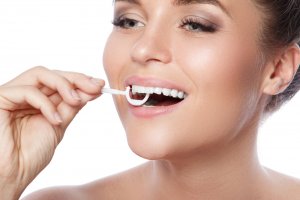

Plaque and tartar build-up on your teeth creates a breeding ground for bacteria, which then start attacking your tooth enamel. It also gives you bad breath, or halitosis. If plaque develops in pockets between the teeth and gums it usually leads to gum disease (gingivitis). This condition eventually causes teeth to become loose and even fall out if it's not treated.
Brushing your teeth properly twice a day is essential for keeping your teeth and gums healthy, and some of the best electric toothbrushes use a pulsing motion to help clean between teeth. But they are still not a complete replacement for flossing.
- Flossing once a day is all that’s required and should be done after brushing all the teeth.
- There are different types of floss, some which are waxed and non-waxed with different thickness. The type and size is not as important as being able to get them between your teeth without extra effort. You may need to try several different types to find one that works best for you.
- Once the floss is through the contacts of your teeth, a gentle up-and-down motion is recommended. You do not have to force the floss into the gum tissue and make it bleed. Initially, your gums may bleed due to inflammation, but after several weeks of flossing this should go away. If not, you should consult with a dentist.
- Flossing around dental implant crowns is different than around natural teeth. As the tissue attachment to an implant is not as strong as a natural tooth, a back-and-forth motion is recommended. Too vigorous up-and-down flossing can separate the gum attachment around an implant crown and result in bacteria entering between the gum and implant surface.
- Using a Waterpik or similar device can be helpful, especially for patients who have difficulty with manual dexterity. Although not a substitute for flossing, it can be a helpful tool in addition to daily flossing.
- Routine hygiene visits with your dentist is important not just to prevent cavities but for gum health and screening for oral cancer as well.
Dr. Nestor Karas, Muir Oral Facial & Dental Implant Surgery
Summary of the benefits
To quickly recap, cleaning between teeth means:
- Cleaner teeth and gums
- Fresher breath
- Less need for painful tartar removal at the dentist
- Fewer cavities (and subsequent tooth fillings)
- Less risk of developing gum disease
- Improved oral health so fewer complications later in life
- Less money spent on dental work!
If this isn't good enough motivation for you, consider this: Looking after your teeth well now should mean that you need less dental work in the future. The cost of fillings, root canals, extractions, crowns, implants, etc. can easily add up, so you could say that flossing now will save you money on your future dental bills.
Having trouble flossing every day?
You're here because you know it's important to floss every day, but sometimes flossing can be painful, difficult, uncomfortable, or just downright boring. If this is a habit you've fallen behind on, you're certainly not alone. Less than a third of Americans use dental floss regularly, and a third have never bothered with it at all.
To help, you may want to consider flossing with a water flosser. Water flossers are a gentle way to clean between teeth and are recommended by many dentists for patients who find it difficult to floss every day for a variety of reasons. One popular option is the Oral-B water flosser, and another is the Waterpik brand, and specifically the Waterpik Cordless Advanced WP-560.
It provides an easy way to clean between teeth, removing up to 99.9 percent of plaque. It features three pressure settings ranging from 45 to 75 PSI and is quiet while operating. Plus it charges quickly and has a cordless design making it great for travel. If you want to modernize the way you floss, click on the button below to check the price.
How to floss your teeth
So, now that you're convinced of the benefits of flossing, what is the correct way to clean between your teeth? There are several factors to consider here, including the timing, frequency, and technique used.
How often should you floss?
The American Dental Association recommends cleaning between teeth once a day. Your dentist probably gives you the same advice every time you visit.
Children can start flossing when they are around 12, but they will need adult help and supervision at first.
The American Dental Association recommends flossing once a day to clean between teeth. Whether you floss in the morning, evening or midday is a matter of personal preference. Flossing before bedtime ensures the mouth is clean while sleeping. But, the goal is a daily flossing to ensure all sides of your tooth are cleaned. Toothbrushing can’t reach in between teeth and up into the gumline like flossing can. Plaque bacteria, if not removed, can cause inflammation of your gum tissue, gingivitis, or gum disease. Irritated tissue is characterized by red, swollen, and bleeding gums. It doesn’t take long to floss, but that little act can result in big benefits for oral health.
Dr. Travis R. Willey, Family and Cosmetic Dentistry of the Rockies
Before or after brushing?
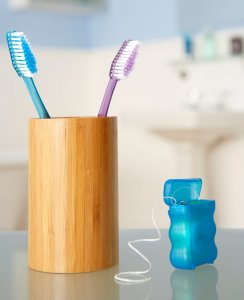

There are mixed theories on this. The most important thing is that you do it.
Some dentists recommend flossing before you brush. The logic behind this is that it helps dislodge any food and plaque on and between teeth so the fluoride in your toothpaste gets better access to the surface of the tooth. It also gets the unpleasant task out of the way first.
On the other hand, there is a case for brushing first because this removes most of the plaque on your teeth and coats them with fluoride. Then, when you floss, this helps work the fluoride between your teeth.
Some experts like the folks at the American Dental Association say it doesn't really matter – as long as you incorporate both elements into your daily hygiene routine. You might want to experiment and see which way around works best for you. The important thing is that you get into the habit of cleaning every surface of every tooth, every day. If you're not convinced, we have a whole article dedicated to the topic.
The best technique
It's easiest to see how to floss teeth properly by watching someone else do it, so here is a short video explaining the technique:
To summarize the steps involved:
- Choose a floss that suits you (waxed or unwaxed; flavored or unflavored; single or multi-strand).
- Break off about 18in.
- Wind some around your index or middle finger on each hand, leaving about 1in exposed.
- Pull it tight and use your thumbs to guide it into place between your teeth.
- Be careful not to force it or snap it onto your gums.
- Curve the floss around one tooth and gently push it as far as it will go, past the gum line.
- Move it up and down along the side of the tooth 8-10 times (not side to side).
- Repeat for the tooth on the other side.
- Gently remove the string from that space and unwind a clean piece to use on the next gap.
- Don't forget to clean the back of your four rear teeth as these can be difficult to reach with a toothbrush.
- Rinse with water or mouthwash (but don't use mouthwash right after brushing). Cheack out our guide to the best mouthwash.
Work your way methodically around your mouth and follow the same pattern every day. This will make it less likely that you miss a tooth.
You might notice your gums bleed a little when you first start flossing. This is probably just a sign that you are doing a good job of dislodging plaque, and the bleeding should subside after a few days of doing it. If it continues, you might need to change your technique or use a different product. Speak to your dentist if this is the case.
We'll explain how to properly floss your teeth using other flossing products in the section below.
Cleaning around braces
Cleaning your teeth gets more complicated if you are wearing any style of braces for adults, teens or children. You can't slide anything all the way down the gap between your teeth since the archwire is in the way.
Check our article on flossing with braces for some tips, techniques, and products to make the process a little less difficult and time-consuming. You might want to invest in a water flosser but speak to your orthodontist to see what he or she recommends.
How to floss back teeth
The steps above go over how to get in between those back teeth, but for many people those hard to reach spaces can be, well, hard to reach! If you're wondering how to floss your back teeth, take a look at this video below for some pro tips.
Products for better flossing
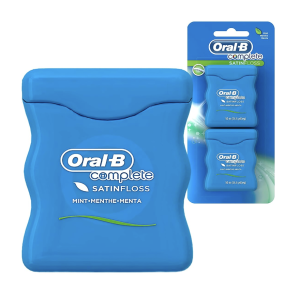

Now let's take a look at the various products available to help you make flossing a part of your daily routine. At the bottom of the page, you'll find a table to quickly compare the main features of each of these.
Dental floss
If you think that all dental floss is the same, think again. This thin string is available with a variety of different features to suit different people's preferences.
For example, you can buy it waxed or unwaxed and with the option of different flavors. It can come as monofilament (single-strand) or multifilament (multi-strand). Monofilament floss doesn't fray and a wax-coated variety, like Oral-B Satin Floss, should slide between teeth more easily. These features increase the cost, but only slightly.
Dental tape
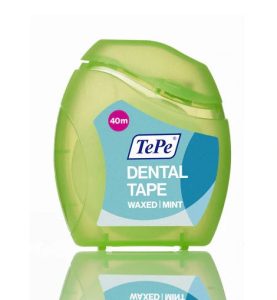

If you have crowded teeth with particularly small gaps then you may get on better with a dental tape. This is exactly as it sounds; a very thin, flat tape which serves the same purpose as string floss.
Dental tape can slide more easily into very tight gaps, so if you struggle with dental floss getting stuck between your teeth, you could give tape a try instead. TePe Dental Tape has a fresh minty taste and is highly rated by people who find floss snags on their teeth.
“Other flosses claim they are a dental ‘tape', but they always seem to be the shortest string and cause severe pain to my gums. These flosses actually have some width. Although it is a bit thicker than the ones I had before, it is still comfortable and covers a larger surface area of each tooth while flossing.”
Sticks/picks
If you struggle with the dexterity required to use string wound around your fingers, you can try using a dental floss stick, also known as a ‘pick' or ‘wand'. These disposable items consist of a short piece of floss suspended between two plastic prongs on a handle. Often the handle is shaped into a point that can be used as a toothpick.
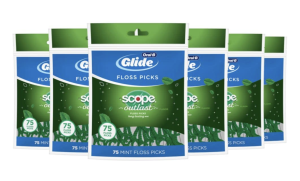

While they certainly make it easier to reach the back teeth, they don't offer the same range of motion and they may miss the area below the gum line. You might find this device more hygienic though, as you aren't touching the bacteria-covered string during use. Consider giving Oral-B Complete Glide dental picks a try if this is an option that interests you.
How to floss your teeth with floss picks
To use a floss pick to floss your teeth, follow these instructions:
- Place the pick between your teeth and gently press down onto your gum.
- Move the pick gently up and down to release food particles and stimulate gums.
- Rinse after you're finished.
Biodegradable floss
If you're looking for an eco-friendly floss, you'll be pleased to hear there are several options available in the US.
One of the most popular is Mother Earth charcoal dental floss, a plastic-free dental floss that comes with a refillable glass container and is flavored with peppermint essential oil.
Natural floss is sometimes not quite as strong as the conventional plastic options, and it may not feel quite as thin and smooth. This is more likely to be a problem if your teeth are crooked or very tightly spaced. Still, if you'd prefer not to be throwing hundreds of meters of plastic floss into landfills every year, these eco options are definitely worth a try.
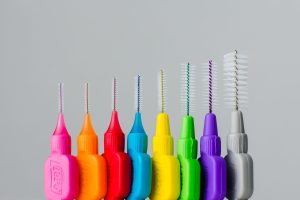

Interdental brushes
If you're wondering how to get something out of your teeth without floss, another effective flossing tool is interdental brushes, like these ones from TePe. These very small brushes are designed to fit in the spaces between teeth and dislodge any plaque or food particles stuck there.
Interdental brushes can be less fiddly than dental floss, and you can read more about the different brands, sizes and types of interdental brush in our full guide. One potential downside is the amount of plastic waste they produce since these little brushes only last 1-2 weeks at most with regular use. However, there are various eco-friendly options that we cover in our guide as well.
Oral irrigators (water jets)
For a more technological approach to cleaning between your teeth and under your gums, you could consider a water or air flosser, which we mentioned briefly above. These hand-held devices, also known as oral irrigators, deliver a pressurized burst of air and/or water between each set of teeth.
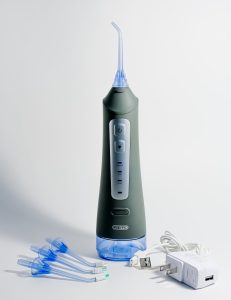

One of the best water flossers on the market is the cariPRO Cordless Water flosser.
The cariPRO features a reservoir that holds 155ml of water for 45 seconds of continuous flossing. It also has three different flossing modes — normal, soft and plus, and a non-slip soft-touch grip. And there are 4 specialty tips!
If you're interested in the cariPRO, go ahead and check it out on the website, you'll most likely find a good deal or two! Check out cariPRO water flosser reviews.
You may also want to consider the Waterpik Cordless Advanced WP-560 water flosser or the Waterpik WP-100, as these are very popular models.
The Philips Sonicare AirFloss is another interesting option, as it combines air and water, using only a teaspoon of water per session.
The general consensus among dentists is that water jets are not as effective as traditional string floss which physically scrapes plaque from teeth. And of course, they are much more pricey. But many dentists recommend them as a supplement to daily flossing.
We gave a separate guide to the best Waterpik in the US. They are the leading brand, but not one of the cheapest.
However, if you have trouble using regular techniques then a water flosser may be the next best thing. They also pose little risk of damage to gum tissue and are much easier to use if you wear braces. If you're considering investing in an electric flosser, check out our guide to the best water flossers available in the U.S.
Air flossers
Air flossers are similar to water flossers, but without the mess. Read more about the differences between air flossers and water flossers and the Waterpik vs. Airfloss debate.
Conclusion
Flossing your teeth well is just one part of maintaining good oral health. In addition, you should:
- Use a fluoride toothpaste
- Limit your consumption of sugary foods and drinks, and avoid snacking on them throughout the day
- Get regular dental checkups and cleanings
Many people find it difficult to commit to flossing every day with normal dental floss. Thankfully, there are plenty of other options available, like picks, water flossers and interdental brushes. None of these alternative options tend to be quite as good as floss as getting the job done, so if you can stick to the real deal, while supplementing with other options, that would be ideal.
While you're brushing up on your flossing technique, we also recommend you have a look at our separate guide to how to brush your teeth.
If you have any concerns about the state of your teeth, don't put off going to the dentist. The longer you leave it, the worse the problem is likely to get. You'll feel much better once any issues have been treated!
FAQs
How do I remove floss stuck between teeth?
If you have floss stuck between your teeth, you should first rinse your mouth with lukewarm water to see if it reduces any swelling that might be causing the floss to stay stuck. Another trick is to try a water flosser to force the floss out without harming your gums, and if that doesn't work, grab the stuck floss from one end and pull it out in a gentle motion.
How often should you floss teeth?
You should floss your teeth once a day, either in the morning or at night, before or after brushing. Most dentists agree that it doesn't matter when you floss, it just matters that you do floss. So choose a time that best works for you.
Is it too late to start flossing?
No! It's not too late to begin flossing. However, if you've never flossed before, your gums may bleed during the first few days. You'll also notice some swelling, and even mild pain. Be gentle and stick with it!
CNN: One-third of American adults never floss, study says. Consulted 21st October 2020.
Sunstar: Global Healthy Thinking Report. Consulted 11th September 2021.








